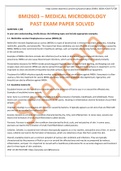Exam (elaborations)
"2023 Comprehensive Collection of Solved Past Papers for BMI2603: An Essential Study Guide for Success in Medical Microbiology"
The document containing all the solved past exam papers and assignments for the Medical Microbiology course at UNISA is a comprehensive study resource for students enrolled in this course. The document is organized into different sections, each containing all the past exams and assignments for a sp...
[Show more]



